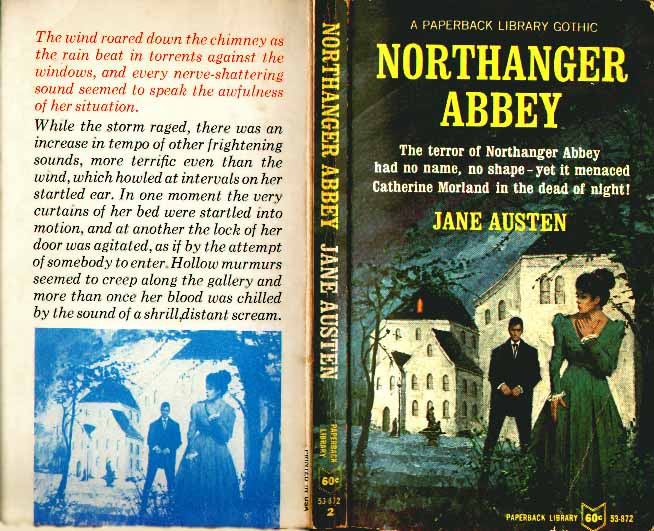 Apparently, when we think of Jane Austen, we think of a writer whose style is so polished and so impenetrable that to imagine her editing or changing her work is to commit a minor sacrilege. At least, that's what this article takes as its baseline -- and it's a baseline I can understand. For most people, books are finished things; their very completeness lends them credibility and solidity, makes them believable even though they are obviously fictions. From this perspective, I can understand why people who don't frequently write literature (or write about literature) might express a kind of shock upon discovering exactly how meticulous Jane Austen was in rewriting her novels, and exactly how unfinished they once were.
Apparently, when we think of Jane Austen, we think of a writer whose style is so polished and so impenetrable that to imagine her editing or changing her work is to commit a minor sacrilege. At least, that's what this article takes as its baseline -- and it's a baseline I can understand. For most people, books are finished things; their very completeness lends them credibility and solidity, makes them believable even though they are obviously fictions. From this perspective, I can understand why people who don't frequently write literature (or write about literature) might express a kind of shock upon discovering exactly how meticulous Jane Austen was in rewriting her novels, and exactly how unfinished they once were.I remember my first experience of this side of Austen. I was a freshman in my first ever English class at Berkeley, and my professor, in a lecture on Pride and Prejudice, mentioned that the novel had once been titled First Impressions and written in an entirely epistolary style. I don't remember my exact response, but I'm fairly certain that rather than shock, I experienced something like regret for the fact that this initial draft of the novel no longer existed.
Since then, I've spent my fair share of time wondering (as I will suppose almost every Austen scholar has wondered, at one point or another) about the possibility that First Impressions could still exist, sitting in a forgotten drawer in an English country estate, or wedged accidentally behind a dresser in a neglected parsonage. After encountering A. S. Byatt's Possession this spring -- in which two modern academics discover the lost letters of two (fictional) Victorian poets, and follow the literary clues therein on a detective hunt through Great Britain and parts of France -- I'll admit, I fantasized about being the person who opened the right drawer, or pulled the right dresser away from the wall, to see the manuscript come fluttering down, the light of day reanimating the dead leaves of paper covered in the veined tracery of aging ink.
This summer, in the process of researching for my senior thesis, I embarked upon a voyage through the collected letters of Jane Austen -- and everything changed.
It didn't happen all at once. Though Austen is always an interesting writer, her letters (mostly to her sister Cassandra) deal primarily with her day-to-day life, referencing people and places and events that my minimal knowledge of Austen biography precluded me from truly understanding. But more important than the actual content of the letters was my growing understanding of Austen's style. I slowly realized that only very rarely did I feel like I could take her seriously -- even when speaking with her sister about serious matters, she always seems to address her own real beliefs from an angle, or reference them only backhandedly. I was shocked to discover that particular passages which older Austen critics frequently read as plain and simple truth were, from my vantage point, obviously spoken with a deep irony that must effect my interpretation.
For example, I had heard more than one critic propound that Austen was dissatisfied with Pride and Prejudice, because in a letter to Cassandra she writes, "the work is rather too light & bright & sparkling;--it wants shade;--it wants to be stretched out here & there with a long Chapter" (Jane to Cassandra, 4 February 1813). I'd been uneasy with this assertion, having personally considered the "light & bright & sparkling" nature of Pride and Prejudice to be the main reason for its critical reputation. An earlier letter only provided more support for my idea; Austen writes that she has "lopt & cropt [Pride and Prejudice] so successfully however that I imagine it must be rather shorter than S.&S. [Sense and Sensibility] altogether" (Jane to Cassandra, 29 January 1813). This pride in cutting her work down to size -- in removing, excising, revising -- seemed out of touch with the Austen described by critics as disapproving of the "bright & sparkling" nature of her own novels.
To me, the falsehood of these critics' views is proven without a doubt by a fuller extract from the very letter they use to support their claims:
"Upon the whole however I am quite vain enough & well satisfied enough.--The work is rather too light & bright & sparkling;--it wants shade;--it wants to be stretched out here & there with a long Chapter--of sense if it could be had, if not of solemn specious nonsense--about something unconnected with the story; an Essay on Writing, a critique on Walter Scott, or the history of Buonaparte--or anything that would form a contrast & bring the reader with increased delight to the playfulness & Epigrammatism of the general stile" (Jane to Cassandra, 4 February 1813).
The continuation of the second sentence does, it is true, suggest ways in which Austen could have lengthened the work -- but the suggestion that such lengthening might be little more than "solemn specious nonsense" suggests to me that the entire passage is a backhanded self-compliment. Why would a woman who has spent some time and effort "lopping and cropping" this manuscript down to size then complain about its "Epigrammatism," which she admits to finding "delightful"? Austen would not be Austen if she digressed from her tightly-woven narratives to provide the reader with essays on writing, critiques on contemporaries, or historical asides. And she understands this about herself -- later she writes, "I could not sit seriously down to write a serious Romance under any other motive than to save my Life, & if it were indispensable for me to keep it up & never relax into laughing at myself or other people, I am sure I should be hung before I finished the first chapter" (Jane to James Stanier Clarke, librarian to the Prince Regent, 1 April 1816). The repetition of "seriously" and "serious" mocks the very notion of such solemnity, which Austen admits would be broken by laughter, either at herself or others, if such a project were to succeed. Even when Austen is serious, I think her avid readers can attest that she is rarely solemn. Sir Walter Scott himself, when speaking of her juvenile writing, summed her up as "the girl of fifteen [who] is laughing, in her corner, at the world" (qtd. in Johnson 29).
Austen's revising mind, then, rather than shocking us, should be acknowledged as a significant factor in her self-as-writer. In fact, Austen scholar D. A. Miller says "the founding gesture of Austen Style is the cut" (34) -- and although he means it in the sense of the cutting remark, I think it's just as applicable to Austen's cutting down of her own prose to achieve the kind of "Epigrammatism" she ironically disclaims. The result is prose that is intentionally "light & bright & sparkling," like a gemstone that must be "cut" in order to betray its true brilliance.
In light of all of this, I realized at some point this summer that even if First Impressions (or Elinor and Marianne, the epistolary original draft of Sense and Sensibility, or Susan, the original draft of Northanger Abbey) existed, reading it would be like attempting to reconstruct a perfect diamond from the fragments left behind on the cutting table, instead of merely going and looking at the diamond where it sits on its plush velvet cushion on a pedestal in the next room, all "light & bright & sparkling." I might still feel a frisson of excitement at the mention of Austen's early drafts, or her lost letters, but my fervor to be the one who makes the discovery (if there is even a discovery to be made) has died down. In the case of Pride and Prejudice, at any rate, Austen's own letters suggest that her cuts were intentional, and produced the result she desired; with this, then, I can be satisfied.
Works Cited
Johnson, Claudia L. Jane Austen: Women, Politics, and the Novel. Chicago: Chicago University Press, 1988.
Le Faye, Deirdre, ed. Jane Austen's Letters. Oxford: Oxford University Press, 1995.
Miller, D. A. Jane Austen, or, The Secret of Style. Princeton: Princeton University Press, 2003.









